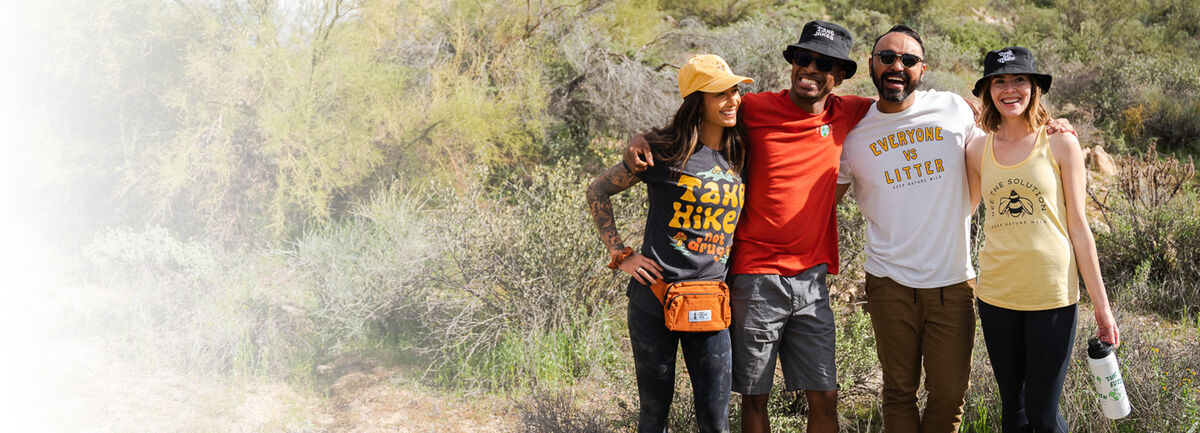
Why Does Picking Up Litter Matter?
Preserving & Caring for Natural Spaces
This post is in collaboration with our partner, Keep Nature Wild, which creates outdoor products inspired by the wild places with the mission to pick up one pound of trash for every product sold.
In celebration of Earth Month, CamelBak and Keep Nature Wild have teamed up to create a limited-edition bottle that includes a Keep Nature Wild Cleanup Kit for Earth Month or any day! The perfect pairing for a day of GiveBak and sustainable outdoor conservation. Pitch in to clean up your favorite outdoor spaces and give back to Mother Nature.
There are so many conservation efforts and ways to create a positive impact for the planet. Below are some compelling stats of why we should all pitch in to cleanup!
- If we spent just one hour today picking up trash, you would potentially remove thousands of pieces of trash, beautifying the area while also protecting wildlife, plant life, waterways, soil and ecosystems from toxic and dangerous chemicals and materials they shouldn’t be introduced to.
- If every person picked up just ONE piece of trash today, there would be over 300 million fewer pieces of litter
- If every person picked up 10 pieces of litter, there would be 3 Billion fewer pieces damaging our environment
- 250 million tons of trash are produced each year in the United States
- Animals from nearly 443 species are entangled in or ingest marine debris annually (imagine urban animals and wildlife near cities, illegal dump sites, campsites and trailheads)
According to the Ocean Conservancy, “The story of plastic is the story of all of us. Plastic touches all our lives, from the food packaging we buy to the computers we work with and the cars we drive. But many of the plastics you touch in your daily life are used only once and thrown away. So much of this plastic is ending up in the ocean that in just a few years, we might end up with a pound of plastic for every three pounds of fish in the sea. But the future of plastics in our ocean will be determined by the way we handle plastics on land."
The BBC shares that there are at least five plastic-infested gyres in the oceans of the world. The Great Pacific Garbage Patch is said to hold the most floating plastic - an estimated 79,000 tons in a region of more than 610,000 square miles (1.6m sq km).
BigRentz.com shared an incredibly eye-opening post about how much waste each state produces, how much waste an average person accumulates annually and the most common products filling our landfills. The post shares that "The typical American produces an average of 4.5 pounds of waste every single day. That’s 1,642.5 pounds a year for each man, woman, and child in the United States. To put that into perspective, it’s nearly as heavy as two horses, or almost half the weight of a 2009 Ford Taurus. That’s a lot of weight!"
The post also shares that while landfill rates have gone down over the past few years, they have been extremely high for decades. BigRentz.com posed the question, "What is in a landfill?" A lot of different stuff. But three categories — food waste, plastics and paper products — account for more than half the garbage accumulated underground. Topping the list of landfill ingredients at 21.9% is food waste.
They also make a point to shine light on the fact that landfills are a major source of greenhouse gasses stating that, "landfills are a major source of methane, a greenhouse gas more than 80 times more powerful than carbon dioxide in destabilizing the environment. In 2019, the EPA reported that municipal solid waste landfills were the third-largest source of human-related methane emissions in the U.S., at 15.1%."
It is important to remember, as humans, we are all part of the problem as we purchase items wrapped in plastic, delivered in non-sustainable or compostable materials and consuming materials rapidly, even purchasing clothing that is fast fashion and throwing them away as they break down quickly. This means, we all have a responsibility to care for the planet and reduce our impact in any way we can.
If you love experiencing nature, you can be part of preserving and caring for these natural spaces by just picking up a piece of trash. You may not have created the problem, but it sure feels good to be a part of the solution.
Are you planning on picking up litter in your local community? Click here to track your impact with Keep Nature Wild. Want to listen to some tunes while picking up litter? Check out CamelBak x Keep Nature Wild collaborative Spotify playlist!


